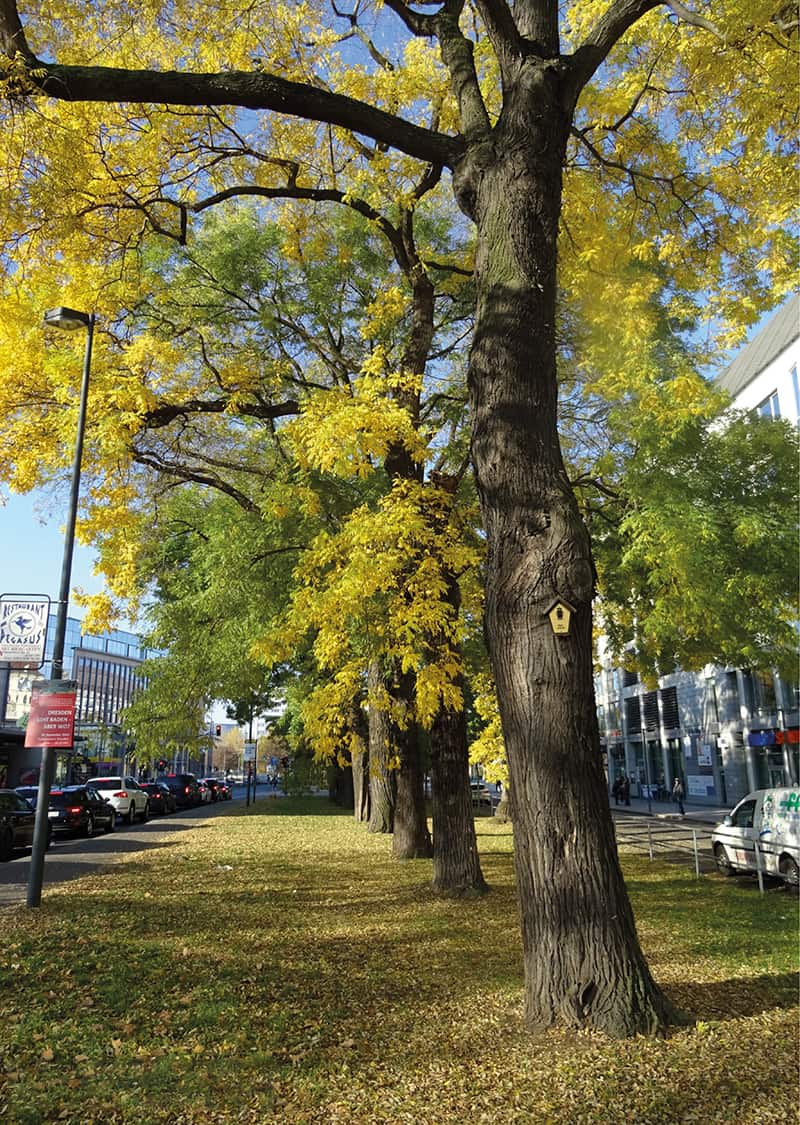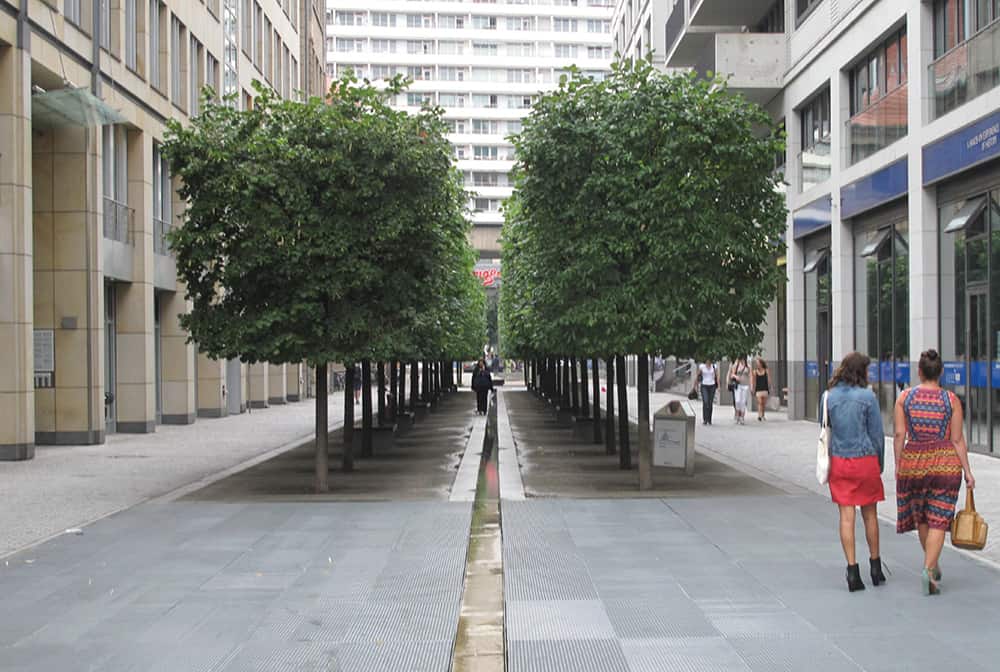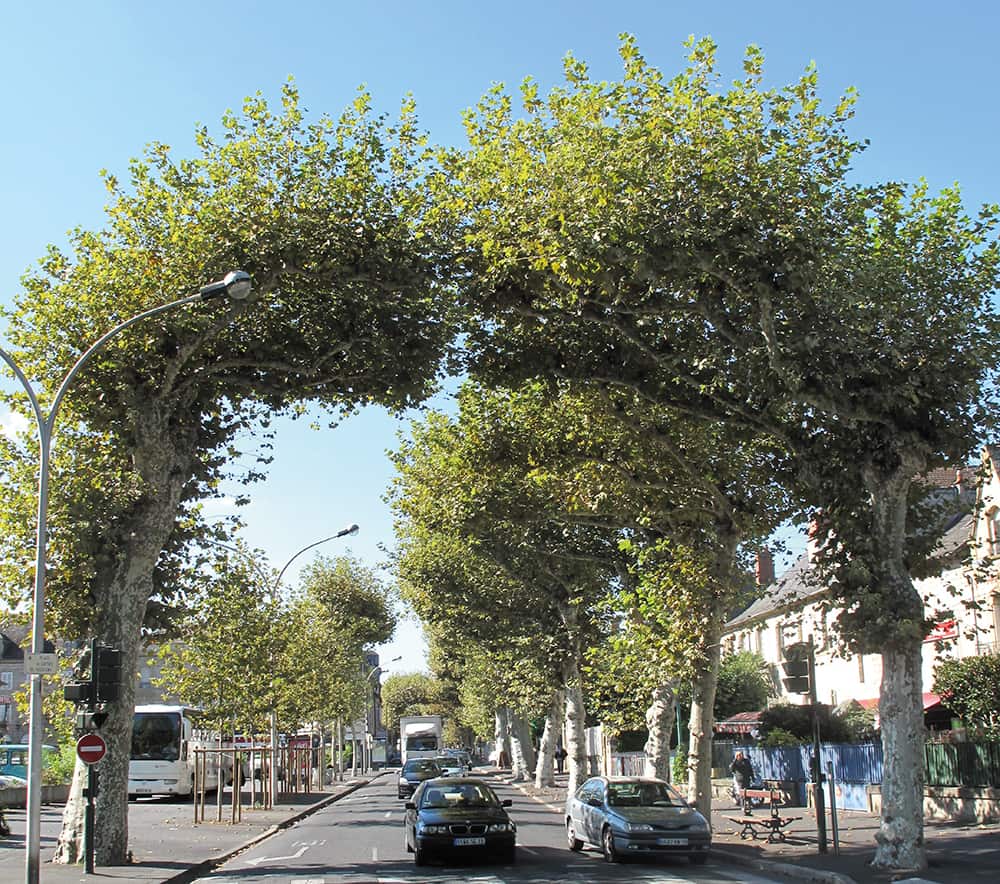Diversity in urban tree populations
Diversity in urban tree populations
Keith Sacre, Barcham Trees

Styphnolobium japonicum used as a street tree in Dresden, Germany.
At the time of writing there is an increasing appreciation of the benefits trees provide, especially in the urban environment. It is generally accepted that more trees need to be planted. Ambitious numeric targets for tree planting, coupled with equally ambitious targets to increase canopy cover by a certain number of percentage points, emerge on an almost daily basis.
Such initiatives at both local and national level are to be welcomed and, some would argue, long overdue. Yet more often than not there is a lack of any evidence base to support the achievability of such targets. The question ‘What have we got?’ remains largely unanswered, and the question ‘Where do we want to be?’ is rarely asked or defined in any sort of long-term strategic management plan for the urban forests of the UK.
It is true that at a time when more planting is being encouraged, urban tree populations face increasing pressures, the most notable being the accelerated introduction of imported pests and diseases and the effects of climate change on urban environments both now and into the future.
Increasingly there is a focus on diversity within urban tree populations and how the strategic pursuit of such diversity offers, through inbuilt resilience, the potential to at the very worst ameliorate some of these pressures and at the very best prevent wholesale damage to highly vulnerable tree populations
Before Covid-19 so unceremoniously interrupted our lives so dramatically I was working on the fourth part of the Barcham Manual Series. The others – entitled Specification Manual, Species Selection Manual and Planting Manual – have all been in circulation for some time, with the Specification Manual now on its fourth print run. The new manual is to be called Resilience through Diversity and has reached a first draft stage with specialists asked to offer their comments and observations. However, work has now stopped and it is unclear when publication will take place.
The purpose of this article is to provide a summary and outline of what is included in the manual and hopefully open discussion and encourage feedback.
What have we got?
The subject of strategic urban forest management begins with the question ‘What have we got?’ Without this knowledge it is difficult to see how resilience can be achieved through diversity. Knowledge of the composition of existing tree populations, with evidence of existing species diversity, age and size class diversity and if possible genetic diversity, is essential if resilience is to be achieved. How is it possible to plan what to plant where and in what quantity without a basic understanding of what is already there?
In the UK at the time of writing the evidence base is fragmented and partial, but what information exists suggests that urban tree populations, while diverse at an individual species level, are highly dependent on relatively few species.
Trees in Towns II (2008), the last comprehensive review of trees in urban areas in England, reported that six species accounted for 37% of all trees and shrubs planted in England’s cities. Evidence from i-Tree studies from around Europe suggests that this has not changed a great deal and that our urban spaces are heavily reliant on a few species.
Recent work carried out by Forest Research to examine 12 i-Tree studies in the UK concluded that locations were typically represented by a small number of species. The challenges of establishing trees in the urban environment have been well documented and should certainly be considered as part of the ‘What have we got?’ analysis. The Trees and Design Action Group (TDAG) has produced two comprehensives documents, Trees in the Townscape (2012) and Trees in Hard Landscapes (2014), which provide a comprehensive assessment of the challenges and offer suggested solutions.
Innovative urban planting in Berlin.
The quality of young nursery trees and how they are planted and maintained are also factors to consider and influence dramatically the ‘What have we got?’ question. This aspect is comprehensively covered in BS 8545 Trees: From Nursery to Independence in the Landscape, published in 2014.
It is also a reality that invasive pests and diseases and climate change are factors which must be considered in any assessment of ‘What have we got?’ They are critical in strategic planning for resilience through diversity. The draft manual looks at the likely impacts of climate change and the potential impacts of imported pests and diseases, from both a historical and a contemporary viewpoint. It concludes that the threats are real – no surprise there – and that the urban environment presents conditions where variables are greater and the number of localised challenges numerous, and it asks how the urban forest can be made resilient, with questions such as ‘What are the plasticity and adaptability of existing populations?’ and ‘What species should we plant to achieve resilience?’ to be answered against such levels of uncertainty.
It is generally recognised that what we want are sustainable urban forests with the capacity to deliver societal benefits both now and into the future. These benefits, both tangible and intangible, have been well documented and there is no necessity to repeat them here.
It follows that there must be a long-term strategic vision for the urban forest of which resilience through diversity is just one of the elements to be considered and planned for. Sadly, the long-term vision is largely absent from urban forest discourse in the UK.
Principal elements of diversity
Within tree populations, diversity can therefore be summarised as being composed of three principal elements. These are:
Species diversity: The proportions of any given family, genus, species and cultivar which make up the total tree population.
Age class and size diversity: Size and age diversity are generally inextricably linked. The older the tree, of any species, the larger it is, but the size of that tree relative to trees of other species is obviously related to the genetic potential of individual species. Diversity within the population is the mixture of ages and sizes present in that population.
Genetic diversity: There is very little in the literature which deals adequately with the question of genetic diversity within tree populations. Certainly, in the urban environment many of the more successful tree species are in fact clonal selections which have been propagated vegetatively either through cuttings or budding. The consequence is that all these selections are genetically identical. Only trees raised directly from seed can display genetic variation. The consequence of clonal selection is that because these trees are genetically identical, they are equally and universally vulnerable to stresses and strains, whether from climate change or pests and disease.
With a general agreement that diversity in tree populations will increase resilience to the impacts of climate change and the potential ravages of invasive pests and/or disease, the question emerges as to how diversity is defined and measured.
How can diversity be defined and measured?
Over the years several theoretical models have emerged of the metrics which can be used to achieve sensible and resilient species diversity within the urban environment. Of these the most frequently quoted is the rule devised by Frank Santamour of the US National Arboretum. He states that the ideal would be that no more than 10% of an urban tree population should be comprised of any given species, no more than 20% of any particular genus and no more than 30% of any given family.
It has elsewhere been suggested that communities should establish maximum population densities for each species as a percentage of the entire street tree population and that no more than 5% of the population should be any one species. More liberal recommendations suggest that proven species should not exceed 10% of the population.
It is recognised and accepted that the larger the tree, the greater the range of benefits it provides. However, tree populations are dynamic: trees are lost and trees are planted, and succession has to be provided, which poses the question of whether there is an ideal age/size matrix which can be applied to any given tree population to ensure a resilient and sustainable future for that population.
The most often quoted and used matrix has s ggested that tree and park populations should be comprised of trees in the following size ranges: approximately 40% with a dbh of 0–20cm; 30% with a dbh of 20–40cm; 20% with a dbh of 40–60cm; and 10% with a dbh of greater than 60cm.
What should we plant?
When diversity in the urban forest is discussed, two questions that are always asked are ‘Which species should be planted?’ and ‘Will the species selected be available from the nursery when it’s needed?’ The often-used statement ‘The Right Tree for the Right Place’ is frequently shown up to be meaningless unless it is supported by worthwhile and well-researched evidence.
There are many publications and catalogues which offer advice and suggestions. The most recent at the time of writing, and certainly one of the most comprehensive, is the Trees and Design Action Group’s Tree Species Selection for Green Infrastructure: A Guide for Specifiers, researched and authored by Dr Andrew Hirons and Dr Henrik Sjöman. This document, which is available as a free download from the TDAG website, provides profiles for over 280 species supported by explanatory guidance (www.tdag.co.uk).
Discussion of species diversity in the urban environment is frequently polarised about whether the planting of native species is preferable to the use of so-called exotic species. Some argue that native is best; some argue for a mixture; some prefer the use of exotics. The real question is whether true diversity is achievable using native species alone. This topic is discussed in full in the manual but it is beyond the space available in these columns to say more here.
Sculpted Platanus hispanica, Brive, France. Diversity in size, shape and form.
Conclusions
Following a discussion about monitoring and review, the manual concludes:
- The impacts of climate change and the increased risks to our urban tree populations from invasive pests and diseases are real and growing.
- It is generally accepted that the resilience of urban tree populations can be increased by the diversification of those populations. This diversity can be achieved through species diversity, age and size diversity, and genetic diversity.
- Widely accepted metrics exist to evaluate diversity within urban tree populations.
- Evidence suggests that diversity in urban tree populations is limited, not only in the UK but across the world.
- The foundation of planning to increase diversity is fully understanding the situation as it is currently, with a supporting evidence base, and answering the critical question ‘What have we got?’
- To succeed, diversification needs to be part of an overall long-term, visionary strategic management plan.
- Research has indicated that there are many species that are not currently used or are infrequently used and which have the capabilities to thrive in the urban environment.
- Specifiers need to be more adventurous in their species choice and relate that species choice to overall diversity objectives.
- Diversity in the urban environment cannot be achieved through the use of native species alone.
- Tree nurseries have to be part of the dialogue, be involved in discussions about species choice and be given the confidence to invest in producing an increased range of material; contract growing made possible by long-term planning is a possible solution.
It has been impossible to condense the whole manual into this article but I hope a flavour of its contents have been presented. I have not included any references as this is not intended to be an academic paper. These will be published in full with the manual.
For further information please contact me at keith@barchamtrees.co.uk.
For information about i-Tree and its use in the UK please contact Kenton Rogers at Treeconomics: kenton@treeconomics.co.uk.
